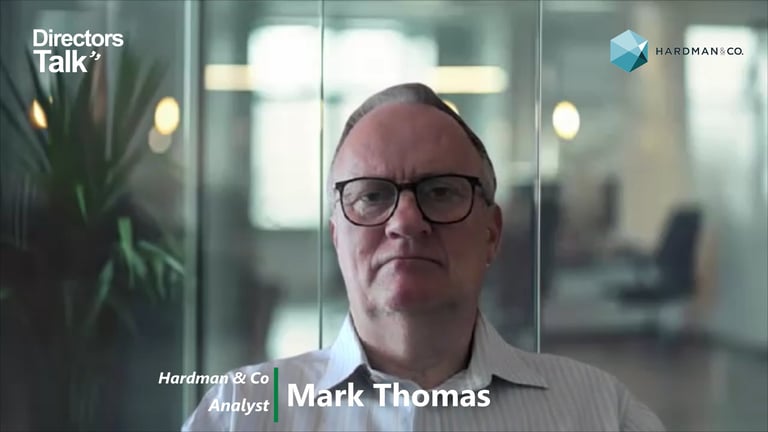Alpha Global Alpha (LON:APAX) is the topic of conversation when Hardman & Co’s Analyst Mark Thomas caught up with DirectorsTalk for an exclusive interview.
Q1: Mark, your recent report sits behind a disclaimer. Can you just remind us why that’s there?
A1: It’s a very standard disclaimer that many investment companies have. In essence, for regulatory reasons, there are some countries, like the US, where the report should not be read. In the UK, because private equity is seen as not being a simple asset class, reports should be looked at by professional and qualified investors. So, it’s a very standard disclaimer, nothing to worry about.
Q2: Now, you’ve called your recent notes for 2024 results ‘Jam Yesterday and Tomorrow, but not today’, what can you tell me about the report?
A2: Apax Global Alpha were very transparent that 2024 was a below average year for the company. It saw a total NAV return of just 0.8%, and that included a fourth quarter return of 2.6%. Now, by comparison, the five-year total NAV compound growth rate is 8.3%.
What we saw in 2024 were problems in health care, which is no longer a core sector, and one portfolio company in particular that meant the strong average investee company EBITDA growth did not fuel the normal NAV growth. However, the detail in results bode very well.
First of all, with that investee company growth delivering mid-teens EBITDA growth, and secondly, the stock of 2025 exitable businesses, ones which are ready for sale, is rising at a time when we have seen increased demand, and this could lead to potential exit uplifts in 2025. Longer-term returns should be helped by accelerating new investment. So, not a good year in itself, but the detail bodes well for the future.
Q3: So, jam tomorrow. Is that in the near-term, or will investors have to wait for years?
A3: In our view, near-term growth in the NAV will be fuelled by both operational performance and a return to more normal exit activity, which sees uplifts on exit. The drag seen in 2024 from problems at the investee company, as I mentioned, the cyclically sensitive stocks, and below normal exit should moderate. We therefore do expect jam in 2025 and in 2026.
Looking beyond that, our previous note has detailed how their hidden gem strategy leads to investing in companies generating superior long-term through-cycle EBITDA growth. By buying companies which need improving, and then improving them, Apax can invest at below-peer ratings and sell at a premium.
The medium-term jam thus reflects investment today. An investment in 2024, €106 million, was nearly twice that of 2023, and we expect calls of €205 million in 2025. This builds a deep, broad pool for value creation.
Q4: Now, exit appears to be important for the 25/26 years for the jam that you referred to. Why are exits rising now?
A4: The key drivers to 2024 growing exit momentum appear likely to us to continue into 2025. AGA has a greater proportion of mature businesses that are ready for sale just at a time when demand in its core sectors appears robust. This demand isn’t IPO-related. There are a whole raft of trade buyers and other financial buyers, so that’s important. Yet the dry powder in funds waiting to be deployed, good availability of finance, significantly from private credit funds dedicated to private equity, and a more stable, if not falling, interest rate environment are all key to that demand in 2025.
Now, clearly, there remain significant uncertainties with both upside and downside potentials, and it’s unclear what the noise around tariffs will do to the IPO market. But management indicates that the nature of its investments means that only a small percentage of its investee companies are directly impacted by tariffs, although, as I say, the wider effects are unclear.
We discussed the benefits of rising exits in much more detail in our note ‘Apax Global Alpha Past Inflection Point with Deal Activity Rising’ which was published on 30 January 2025.
Q5: Why do you also highlight the new investment creates in the pool for long-term value?
A5: The latest Apax fund, which is Apax XI, is still very early in its investment phase, but it represents, by some margin, Apax Global Alpha’s greatest level of commitments. Now, the rapid deployment of this commitment should mean the earlier delivery of Apax-owned value creation, the hidden-gem strategy I mentioned, and so now the creation to Apax Global Alpha.
What we’ve seen is there’s been more deal activity on investment, hence the larger numbers of investments, which I mentioned earlier, and the long-term growth of the business and shareholder NAV is driven by that new investment, so an acceleration there is very encouraging.
Q6: Finally, Mark, what can you tell me about the risks?
A6: Sentiments to cost, the cycle, valuation, overcommitment are all there, and they’re sector-wide issues. The derived investment portfolio is reducing in size, and it generates income towards dividends and has liquidity and capital benefits, but it complicates the private equity story.








































